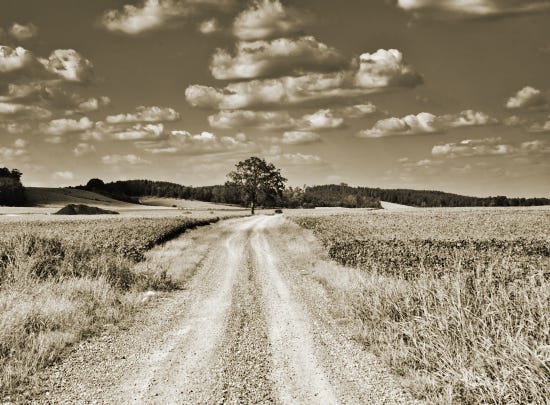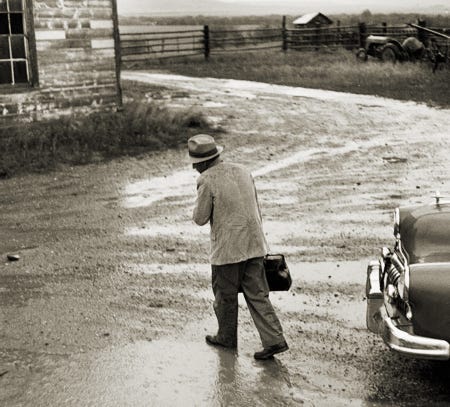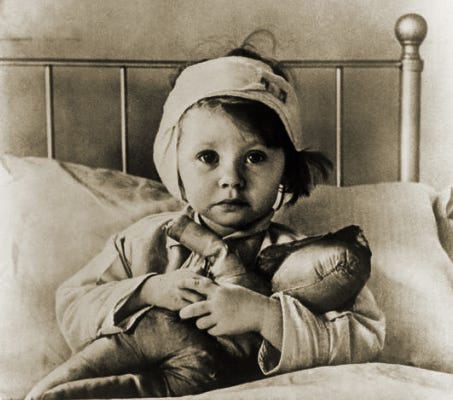The direct quotes in this story are from a taped interview of my mother, Katy, when she was 75 years old. The tape and transcript of her voice is a priceless treasure to her family.
Katy and the Family Doctor
Home remedies and rural health care in the 1930s
“In the 1930s, there was just one doctor in the little town of Esmond, but this one doctor couldn’t cover all the farms and see all the people. And he did a lot of drinking, anyway, so he really couldn’t be counted on for help. I guess he wasn’t really much of a doctor. People didn’t trust him, so mostly the families just doctored themselves.”
“Everybody had their own remedies in those days, for colds and stuff like that. For a cold, mama would give us a clove of garlic to suck on. That really helped. And for boils, she made a poultice out of onions and mustard and wrapped it around you with a towel. And we used a lot of chamomile tea. Chamomile just grew wild in the pastures and mama would gather it up and dry it and put it in a pillow sack, in case we needed it in the winter. That was good stuff.”
In the first part of the 20th century, North Dakota laws relating to public health practice were very basic. To practice medicine in the state, a person had to be a graduate of a school of medicine, and “be of good character”. After 1912, applicants for medical licenses had to have four years of college with at least eight months of that completed at a qualified medical school. A physician’s license could be revoked by a State Board of Medical Examiners if they were found to “show improper conduct, incapacity, or negligence.” They could also be fined for practicing without a license.
“My mother seemed to know what to do if we had illnesses. We didn’t see the doctor much. If we were sick with a stomach ache, mama would make a pudding out of flour, milk and sugar — a pasty, floury pudding. It wasn’t real pudding, but we kids liked it because it was sweet. If you had something like the flu and couldn’t keep anything on your stomach, you could keep that pudding down and it made you feel better. That was something that was good for us and made us well.”
In the 1920s, only 15% of the North Dakota population lived in towns or cities. All the rest were living on farms or in small rural villages. There were only a few people per square mile, and rural doctors had to serve impossibly large areas. All the larger towns had doctors, even some places with a population less than 500 had their own physician. The rural areas, though, began to lose their doctors for two reasons. First, it was hard, hard work to be a rural doctor with patients scattered around so many miles, and they were paid very little. And second, most of the graduates of the medical school at the University of North Dakota did not stay in the state after completing their training. Many became specialists to attain higher incomes, rather than remaining general practitioners, and they had to establish their practices in cities. In 1950 only 111 of the 660 medical school graduates chose to practice in North Dakota, where they were trained.
Katy’s mother was ethnic German, but was born and raised in Ukraine. She had learned home remedies from her own Ukrainian mother. She knew how to doctor her family.
She was taught to use a paste of equal parts of oatmeal and water to stop itches and to treat bug-bites. She used ginger tea to reduce nausea or upset stomach. Wild-growing dandelion greens were cooked and eaten like spinach to help treat arthritis. Dandelion roots were roasted like coffee and used in herbal remedies as a diuretic, a laxative, a tonic and to treat the common cold.
Her mother relied on onions for treating nearly everything. They were used orally to treat flatulence, whooping cough, fever, colds, bronchitis, hypertension, angina, asthma, diabetes, and as a diuretic! Topically, she used onion to treat insect bites, burns, warts, bruises, corns and calluses and to stimulate hair growth in cases of baldness.
“Oh my mother used onions as medicine a lot. She swore by a tea made from onion skins that her mother and grandmother always used, to relieve women’s cramps. It tasted terrible, but I sweetened it a bit with honey. That onion tea soothed my pain faster than any pill.”
Folk remedies are still used today in Ukraine, as in most European and Asian countries. I personally cannot recommend these or testify to their efficacy, but just about any Ukrainian woman would tell you this.
• For a stuffy nose or sinus, chop up some garlic and boil it in a pan, then stand over it and breathe in the fumes.
• Treat a cold with honey, lemon and hot tea.
• Soothe your hurting feet by immersing them in a hot water and mustard foot bath.
• Cure a sore throat by pressing a cloth soaked in warm water and cognac (!) against it.
• For ulcers, drink a shot of hard liquor mixed with a raw egg. A shot of hard liquor is considered to be a fine cure for an upset stomach, too.
• For a tea that loosens mucus and relieves the frequency and duration of coughs, steep fresh thyme in a cup of boiling water and adding honey.
“When we were young, whenever one of us kids would start to feel sick, my mother would have us gargle warm salt water, especially if we had a sore throat, runny nose, or any flu-like thing. Her mother had taught her that salt killed the germs in the throat. I still use salt that way today.”
Though they rarely saw a doctor and were subjected to myriad onion cures (and were less than fastidious about washing their hands or bathing, according to today’s standards,) all six Schloss kids grew up hale and hardy and lived to a fine old age.









Salt water gargle for a sore throat...we still use today. 😊 And, a Neti pot for stuffy sinuses.
I just happen to have a lovely apartment for rent. Write for floorplan and particulars. Its right next to mine, with magnolia tree in the front and zillion flowers all season. That would be super )))